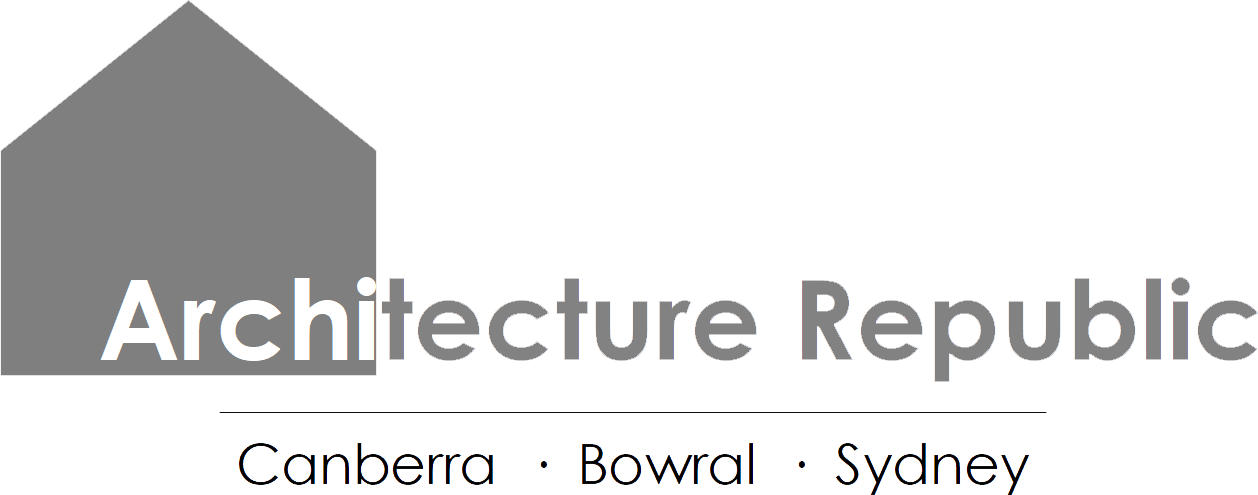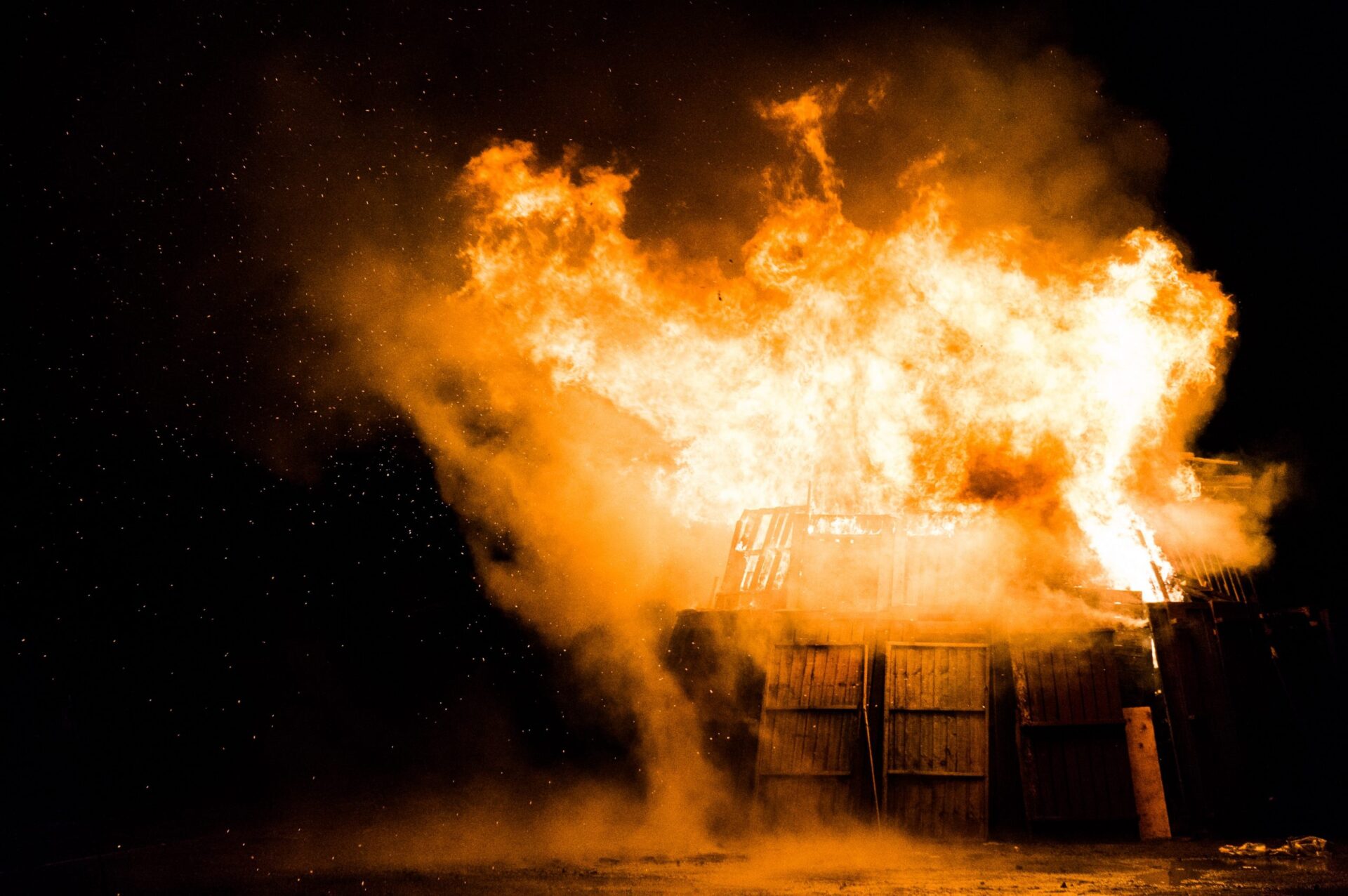
Our first day back at the office for 2020 wasn’t normal. Though, nothing about the heat, smoke and fire of this Australian summer has been normal. With catastrophic bushfire impacting nearby towns of Bundanoon, Penrose, Wingello, Bargo, Balmoral and Kangaroo Valley, we are on high alert every day. Bushfire has already affected two of our rural projects with several other close calls. We have never experienced a bushfire season with this scale, extent and ferocity. Although we are still in its midst, there is a lot we can learn from these fires and many important reminders.
So, we sat down and put together this article. We want to clarify our own thinking and communicate our thoughts on the future of designing for bushfire in Australia.
Our New Normal
- Bushfire is affecting areas which have never been burnt before and areas that aren’t considered ‘bushfire prone’.
- The bushfire season is longer. There is an increase in extreme fire behaviour (like fire tornadoes and pyrocumulus clouds/storms).
- Bushfires are moving fast. Embers start spot-fires many kilometers ahead of the fire front.
- Staying to defend property in a bushfire prone area is dangerous and often impossible, even for professionals.
The Bushfire Construction Code
We have a Bushfire Construction Standard in Australia: Australian Standard 3959: Construction of Buildings in Bushfire Prone Areas (aka “AS3959”). The National Construction Code requires buildings in “bushfire-prone” areas to be constructed according to this code. You can find out if your block is “bushfire-prone” by going to: ACTMAPi (ACT), Planning Portal (NSW) and VicPlan (Victoria). If it is not prone, you don’t legally need to build for bushfire (for now).
If the map does show your property as bushfire prone, then you need to find out your ‘Bushfire Attack Level’ (BAL). We recommend that you use a BPAD certified professional.
We calculate BALs based on the slope and vegetation around your house over a distance of 140m. Generally the steeper and more vegetated the site, the higher the BAL. The Standard gives construction requirements for each BAL:
- BAL-LOW: no requirements
- BAL-12.5 to BAL-40: requirements designed to withstand increasing severity of ember attack and radiant heat
- BAL-FZ: the ‘Flame Zone’ where flames from bushfire may come into contact with the building. Very strict requirement
Although AS3959 is based on the reviews of previous bushfire disasters, the 2019-2020 fire season shows us that the requirements are not good enough. We expect and hope that the legislation will be heavily revised after this summer.
Here’s What We Think
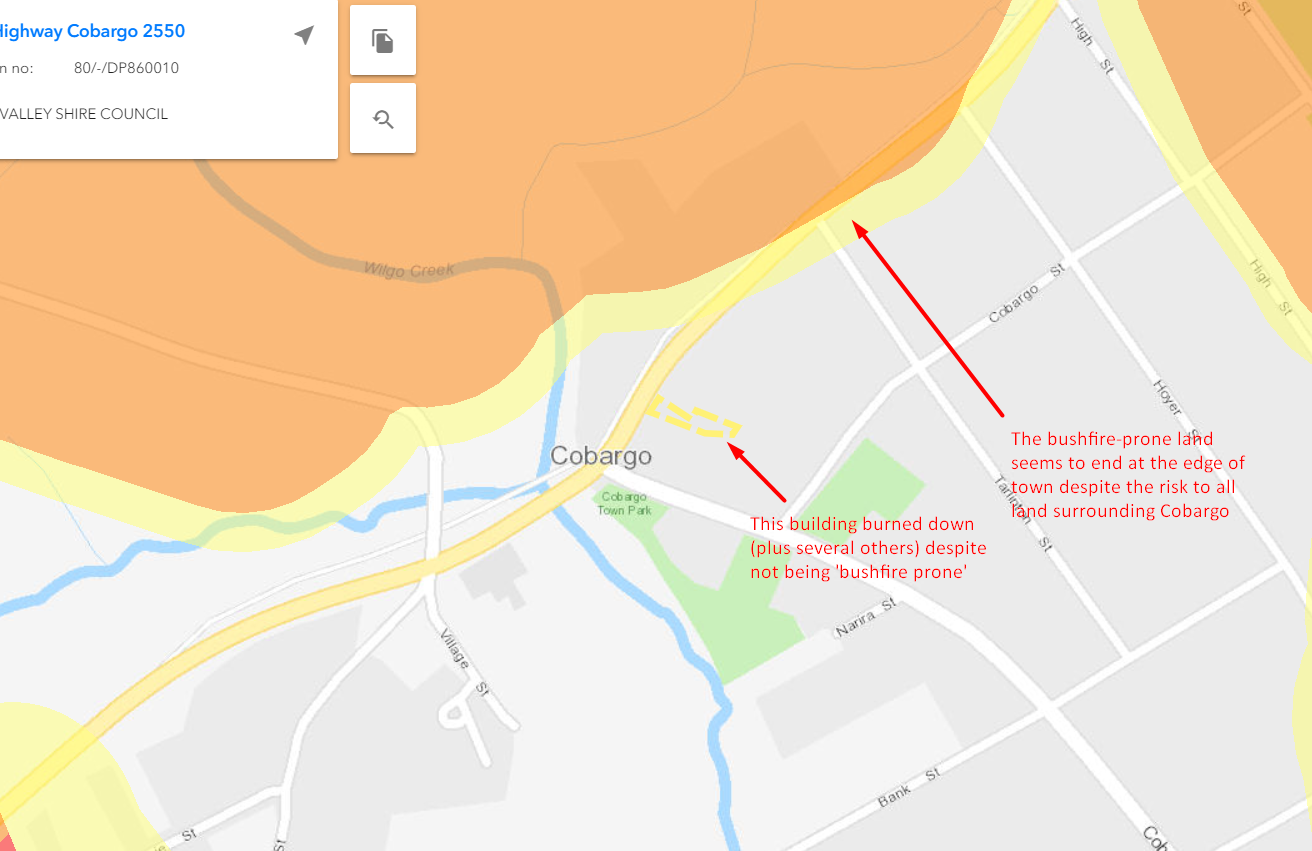
Cobargo – the “bushfire-prone” land surrounding the town is marked in orange.
The “bushfire prone” and “not bushfire prone” definitions are flawed
Ember attack now occurs in areas not mapped as ‘bushfire prone’ such as Batlow, Cobargo and Quaama (all this year). We have seen buildings lost in these towns. New buildings in these non-bushfire-prone areas are not currently required to meet AS3959 and old buildings are vulnerable to ember attack and fire. We should treat everywhere as “bushfire prone”. We should adapt all existing buildings to resist ember attack and construct all new buildings to resist ember attack.
The BAL calculation should not only be based on land within a 140m radius
Fires this season move fast. Currently, AS3959 calculates your BAL based on the slope and vegetation around your house over a distance of 140m. This isn’t good enough. The Dunns Road and Countegany fires each travelled over 50km in the space of a few days. High winds blow embers long distances away from affected bushland. This means your property could be over 20km away from fire but still experience ember attack.
You can’t “manage” a gum tree
In AS3959, there are no bushfire construction requirements if the surrounding land is ‘managed land’. This is defined as gardens, lawns and parkland. This managed land can still include flammable native vegetation in backyards or nature strips. There is no qualifier for whether this land has been managed well (or managed at all) to reduce fuel loads. During a drought and water restrictions, ‘managed’ land is just as combustible as bushland. In fact, even if it was regularly watered and filled with fire-retardant plantings, ember attack can still come from further away. Again, we now know that everywhere is “bushfire prone” unless proven otherwise.

Managed Land in East Bowral (despite the high bushfire threat of dry mulch and gums)
There is no such thing as a ‘bushfire-proof’ house
Many of the houses lost this season have been built from steel, brick and concrete. Unless they are built to the highest standard, embers can get in and ignite timber roof structures and decking. Once timber structures like decks and roofs are alight, brick and concrete walls will often collapse and split open, no longer providing shelter. Aluminium windows will melt above 660°C and direct exposure to flame can easily exceed this. So although aluminium windows are less likely to combust than timber windows, they aren’t protection against direct flames and radiant heat.
The construction requirements in AS3959 are designed to save lives, not property. The building may provide shelter while a (‘normal’) fire front passes through, but this does not mean the house is ‘bushfire proof’. It does not mean the building will survive the fire.
Many materials designed to withstand ember attack will still eventually ignite if exposed to fire for long enough. (e.g. fire-resistant timber listed inAS3959). If a house is not going to be actively defended (e.g. a weekender), then it should be built to a higher construction level.

Ember Attack (learn more here)
What can you do?
Here are our thoughts on how to improve bushfire resistance in all houses:
Upgrade existing houses to meet AS3959
- Reclad timber/weatherboard buildings with non-combustible + bushfire-rated claddings. Some options: Knotwood, Colorbond, Fibre-cement boards like Scyon, Inex + Cemintel, Weathertex/
- Seal gaps in wall cladding by covering, overlapping or using non-combustible sealants
- Seal gaps in roof cladding with perforated steel mesh or mineral wool
- Avoid flammable products like foams and external timber (e.g. SIPs, rendered XPS + EPS cladding)
- Add metal screens to window openings
- Screen vents and openings with corrosion-resistant steel
- Upgrade glass (particularly old 3mm glass) to 5mm or 6mm toughened glass
- Replace timber + upvc windows with aluminium, steel or aluminium composite windows.
- Add bushfire shutters to windows.
- Replace timber decks with light-gauge steel structures (e.g. Spantec) + non-combustible decking (e.g. HardieDeck, Inex, + Knotwood)
- Replace poly (plastic) water tanks with metal or concrete water tanks.
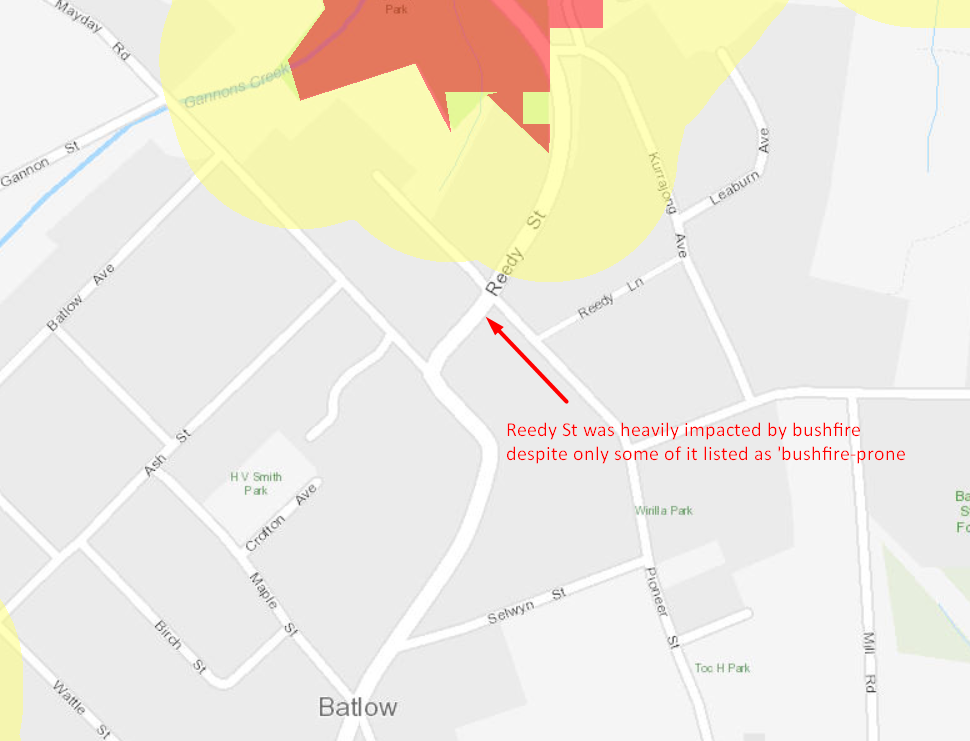
Batlow’s Fire Risk – Buildings in the yellow ‘buffer zone’ were lost to fire.
Manage Bushfire-prone Vegetation
AS3959 doesn’t currently specify standards for vegetation around buildings. After this fire season, we can expect this to change!
- Plant fire resistant and fire retardant plants in preference to explosive plants such as gumtrees, native scrub and pine trees. Here is a list of Fire resistant natives and fire-resistant non natives.
- Avoid construction close to native vegetation (particularly gum trees) and pine forests. Because of the high quantities of eucalyptus oil, no amount of ‘management’ will stop a gum tree being extremely flammable and even explosive. Many species also drop large amounts of leaves and bark throughout the year. This results in flammable materials in gutters and across the ground.
- Avoid any kind of pine or conifer near buildings. Again, these trees contain high concentrations of potentially explosive pine oil. If you have pines or conifers near or over your house, apply to have them removed. Most councils are in favour of removing pine trees.

Part of what made Canberra’s 2003 fires so vicious was the explosive pine tree plantation that backed onto the suburb of Duffy.
Don’t build in the Flame Zone
Areas with BAL-FZ ‘flame zone’ may have bushfire flames directly against the house. In catastrophic conditions, it is impossible to defend a house in this situation. Don’t build in the Flame Zone.
- Where houses are ‘designed’ for the flame zone, they are only designed to provide shelter for a limited time while the fire front passes over. After the fire front has passed, the house is likely to be destroyed or severely damaged.
- In NSW it is extremely difficult to get approval to build in the flame zone. All applications must go through the RFS. RFS are unlikely to approve a house without very fire-robust (expensive) construction methods and clear escape routes (which usually don’t exist on flame zone properties!) Approvals are at the discretion of RFS and they are justifiably reluctant to approve houses in the flame zone!
- Building in the flame zone can be extremely expensive. For example, flame-zone rated windows can be as much as five times the price and you will need to replace them after a bushfire. They are designed with an intumescent layer which hardens in extreme heat to form a barrier against flames. Once fire activates this layer, the windows are no longer functional.
- A bushfire bunker, coupled with building outside the flame zone, is a far more cost effective option. A bunker can be used as a shelter of last resort during a bushfire. It should, however, form just one part of a bushfire survival plan – leaving early is always preferable.
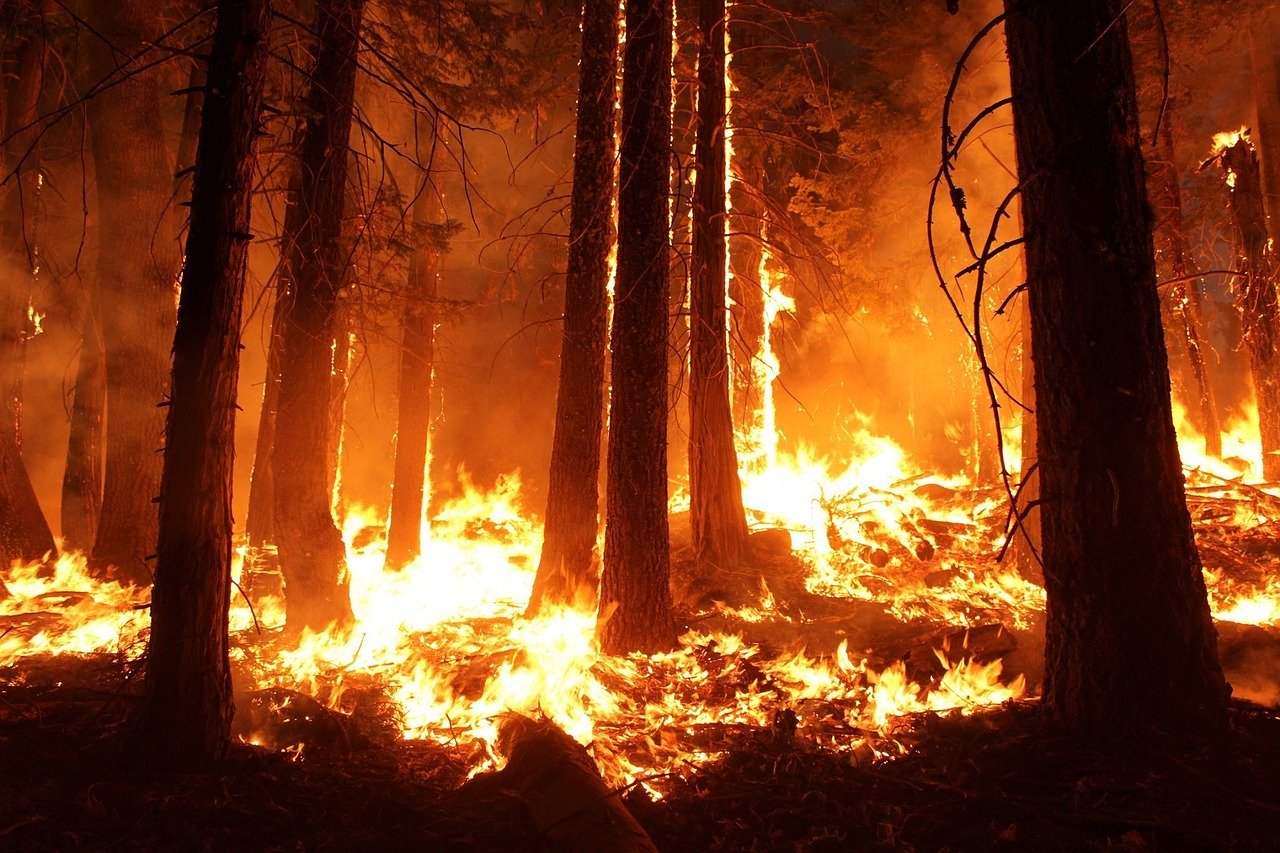
Plan Ahead
- Always have home and contents insurance. This needs to cover full reconstruction of your home and replacement of your possessions.
- Leaving early is always the best option as it protects your life and reduces the risk to firefighters
Cobargo has been our biggest shock this summer. We never expected that this town would be under threat or experience ember attack. We never expected the buildings in the main street would burn down. Some of these buildings had survived over a hundred summers before this one. By old metrics, the town was not bushfire prone. It was simply too far away from the forest that was on fire to the northwest. Now we know to build for ember attack even in non ‘bushfire prone’ areas: even in town, even in the suburbs. Going forward, we must design new buildings and adapt old buildings to meet AS3959. Also, avoid flammable plantings anywhere near built areas. And finally, there is no such thing as a fireproof house; don’t build in the flame zone. Ever.
